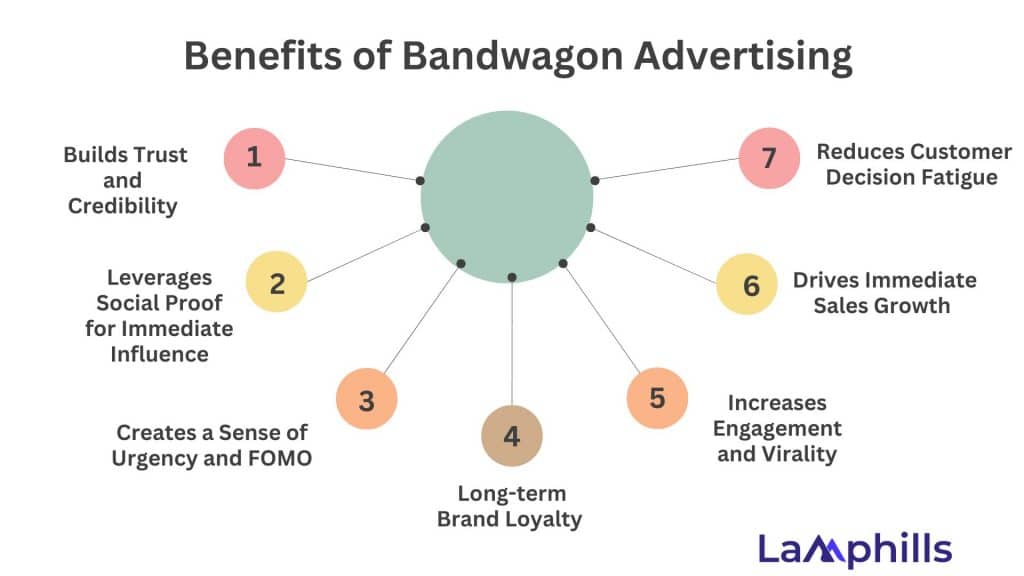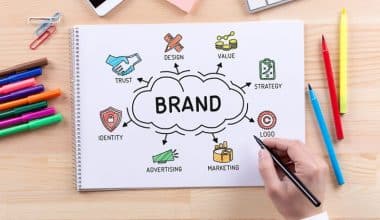Have you ever noticed how people flock to buy the latest gadget, trendy sneakers, or must-have fashion item, simply because everyone else seems to be doing it? This phenomenon isn’t just by chance—it’s a strategic marketing approach known as bandwagon advertising.
I’ve seen the power of bandwagon advertising unfold over time. For instance, the latest iPhone series was bought on pre-order and a report says it was sold out in record time. The people who ordered this product mostly want to be part of the first set to use Apple’s latest iPhone product, nothing else. Generally, people want to be part of something bigger, and this is exactly what bandwagon advertising taps into: the innate human desire to belong.
In this article, I’ll break down why this advertising technique works, the psychological mechanisms behind it, and how your business can leverage it to drive sales.
Key Points
- Bandwagon advertising is a marketing strategy that convinces consumers to purchase a product or service by suggesting that many others are already doing the same.
- It plays into the “if everyone else is doing it, why aren’t you?” mentality, encouraging people to jump on the bandwagon.
- The success of bandwagon advertising lies in understanding two human psychology: social proof and fear of missing out on FOMO.
- Social proof and fear of missing out FOMO are the psychologic behind bandwagon ads.
What Is Bandwagon Advertising?
Bandwagon advertising is a marketing strategy that convinces consumers to purchase a product or service by suggesting that many others are already doing the same. This approach plays into the “if everyone else is doing it, why aren’t you?” mentality, encouraging people to jump on the bandwagon.
Businesses that master bandwagon advertising often see exponential growth in sales. Why? Because people trust popularity. The more they see others engaging with a brand, the more inclined they feel to join in. This is especially relevant in today’s digital age, where social media amplifies the reach of trends at a staggering pace. Consider this: a 2023 Statista report highlighted that 73% of consumers are influenced by social media trends when making purchasing decisions.
The Psychology Behind Bandwagon Advertising
The success of bandwagon advertising lies in understanding human psychology. Two primary psychological drivers make this technique so effective:
#1. Social Proof
Coined by psychologist Robert Cialdini, social proof suggests that people look to others to determine their actions, particularly in uncertain situations. Seeing others purchase a product provides a powerful nudge, making it seem like the obvious choice.
#2. Fear of Missing Out (FOMO)
The bandwagon effect is fueled by FOMO, a fear that if we don’t act quickly, we’ll miss out on something valuable. In fact, according to a study by Eventbrite, 60% of millennials make purchases due to FOMO, demonstrating how prevalent this fear is in today’s consumer behavior.
These psychological principles create a strong emotional pull. People want to feel included in trends and avoid being left behind. This is why brands that master bandwagon advertising can rapidly gain traction.
How Bandwagon Advertising Boosts Sales
Based on years of firsthand experience in marketing, the following are some ways bandwagon advertising directly translates to increased sales:
#1. Builds Trust Through Popularity
Generally, people trust what’s popular. When consumers see that others are buying or endorsing a product, credibility sets in. According to HubSpot’s 2023 Consumer Behavior Report, 55% of consumers say they trust product recommendations by others
#2. Creates Urgency and Scarcity
Another benefit of bandwagon advertising is the perception of scarcity. When people see a product in high demand, they assume it may sell out soon, pushing them to make quicker purchasing decisions. This sense of urgency can make all the difference in a crowded marketplace.
Take Apple, for instance. When a new iPhone is released, the company doesn’t rely on features to drive sales—it leverages the bandwagon effect. People line up for hours, not necessarily because of the phone’s capabilities, but because everyone else is doing it. This creates a ripple effect where others are pressured to join the trend.
Benefits of Bandwagon Advertising

Let’s take a deeper look at the tangible benefits of this advertising technique:
#1. Builds Trust and Credibility
When consumers see that others are purchasing a product or engaging with a brand, it instantly builds trust. Popularity signals reliability, making people more likely to follow suit. According to HubSpot’s 2023 Consumer Behavior Report, 55% of consumers trust recommended products. This trust can significantly reduce hesitation in buying decisions.
#2. Leverages Social Proof for Immediate Influence
Bandwagon advertising relies heavily on social proof, which refers to people’s tendency to follow the actions of others when they’re unsure of what to do. This influence can quickly sway consumer behavior. According to Nielsen, 83% of consumers are more likely to purchase based on peer recommendations, showing the immense power of social proof in decision-making.
#3. Creates a Sense of Urgency and FOMO
The fear of missing out (FOMO) is a significant driver in bandwagon advertising. When consumers feel they might miss out on a popular trend, they’re more likely to make impulsive purchasing decisions. A 2022 Eventbrite survey found that 60% of millennials have made purchases driven by FOMO, demonstrating how this sense of urgency can dramatically boost sales.
#4. Long-Term Brand Loyalty
Once a customer jumps on the bandwagon, they’re more likely to stay loyal to the brand. In my experience, the initial excitement of following a trend leads to longer-term relationships, particularly if the product meets their expectations. According to a 2022 survey by Yotpo, 60% of consumers remain loyal to brands they feel connected to through social proof and community-driven marketing. This combination of urgency and long-term loyalty is a powerful driver of sustainability.
#5. Increases Engagement and Virality
Once a product or trend gains momentum, it can spread like wildfire, particularly through social media. Bandwagon advertising often creates viral moments, where users share their experiences with a brand, encouraging others to do the same. User-generated content (UGC) increases engagement and expands a brand’s reach, making it easier for campaigns to go viral.
#6. Drives Immediate Sales Growth
Tapping into group mentality and social proof often leads to faster purchasing decisions. Consumers are driven by the perception of others, creating a rush to buy before stock runs out or the trend fades. This immediate desire to follow the crowd can lead to a noticeable spike in sales.
#7. Reduces Customer Decision Fatigue
Customers can experience decision fatigue when choosing between multiple products. Bandwagon advertising simplifies the decision-making process by making popular choices seem logical. This cognitive shortcut reduces hesitation, driving quicker conversions and helping consumers feel more confident in their choices.
Strategies to Implement Bandwagon Advertising in Your Business
From working with both large and small businesses, I’ve found several effective ways to harness the power of bandwagon advertising. Here’s how you can start:
#1. Use Social Proof as a Marketing Tool
Display customer reviews, testimonials, and user-generated content on your platforms. Real people showcasing your product give new customers the confidence to purchase.
#2. Influencer Marketing
Collaborating with influencers is a powerful way to create a bandwagon effect. Influencers bring credibility and show that “everyone” in their follower base is using your product. A 2023 study by Influencer Marketing Hub showed that businesses earn $5.20 on average for every dollar spent on influencer marketing.
#3. Leverage FOMO
Create campaigns that highlight limited-time offers, exclusive releases, or low-stock messages. Customers are compelled to act fast when time is running out or others are buying quickly. For example, online retailers often use real-time alerts such as “Only 3 left in stock!” or “10 others are viewing this product,” which significantly increases conversions.
Common Pitfalls of Bandwagon Advertising (and How to Avoid Them)
While bandwagon advertising can be incredibly effective, there are a few risks that need to be managed carefully:
#1. Oversaturation of the Market
One of the biggest risks with bandwagon advertising is oversaturation. When too many brands jump on a trend or adopt similar messaging, the market becomes crowded, and consumers start tuning out. This can lead to advertising fatigue, where potential customers become desensitized to the campaign and no longer find it compelling.
How to Avoid Oversaturation of the Market
To stand out, focus on delivering unique value. While bandwagon advertising plays on popularity, your brand should still differentiate itself through personalized messaging, product features, or customer experiences. Offer a fresh angle, and keep your campaign relevant to your target audience rather than blindly following every trend.
#2. Alienating Non-Conformists
While bandwagon advertising targets those influenced by group behavior, it can alienate consumers who value individuality. Some customers prefer to make decisions independently, and the pressure to conform may turn them off. This can lead to negative perceptions of your brand, especially among niche markets prioritizing uniqueness.
How to Avoid Alienating Non-Conformists
Balance bandwagon messaging with inclusivity. Ensure your advertising doesn’t rely solely on peer pressure or FOMO tactics. Highlight the unique aspects of your product that appeal to individualistic customers, and offer personalized experiences that allow them to feel valued for their distinct choices.
#3. Temporary Engagement with No Long-Term Loyalty
The bandwagon effect can drive quick sales, however, it doesn’t have depth. Once the hype dies down, consumers may lose interest and move on to the next trend. This means brands could face high customer churn rates if they don’t find ways to build deeper connections beyond the trend.
How to Avoid Temporary Engagement with No Long-Term Loyalty
Focus on delivering value after the initial sale. You can cultivate a loyal customer base by providing exceptional post-purchase support, offering exclusive deals, and creating brand experiences beyond the bandwagon effect. Encourage long-term engagement through personalized follow-ups and loyalty programs to turn one-time buyers into repeat customers.
#4. Risk of Being Perceived as Inauthentic
Bandwagon advertising can sometimes be inauthentic if the brand is seen as hopping on a trend solely for profit without genuinely aligning with the message. This can lead to brand dilution or damage if consumers perceive the campaign as a desperate attempt to capitalize on what’s popular rather than staying true to the brand’s values.
How to Avoid Risk of Being Perceived as Inauthentic
Ensure that any trend you jump on aligns with your brand’s core identity and values. Authenticity is critical to maintaining credibility. Be selective about which trends to follow and create campaigns that reflect your brand’s mission and voice, not just what’s momentarily popular.
#5. Short-Term Gains but Long-Term Brand Damage
If a bandwagon campaign is not properly aligned with the brand’s long-term strategy, it can lead to short-term success at the expense of long-term brand positioning. Chasing quick trends may dilute your brand’s identity, causing confusion among your audience and making it difficult to regain a consistent image.
How to Avoid Short-Term Gains but Long-Term Brand Damage
Before launching a bandwagon campaign, ensure it fits your broader brand strategy. Ask whether the trend you’re following supports your long-term goals. Consider whether it enhances or detracts from the brand story you’re building. A well-planned campaign will balance short-term gains with sustainable growth and brand equity.
#6. Ignoring the Core Audience
Brands may neglect their loyal core audience in a rush to appeal to the masses. If the campaign focuses solely on the general trend, you risk alienating your existing customers, who might feel disconnected from the brand they previously supported. This can hurt customer retention and loyalty.
How to Avoid Ignoring the Core Audience
While bandwagon campaigns aim to attract new customers, don’t forget about your loyal audience. Maintain a balance between appealing to new consumers and nurturing your existing base. Tailor different versions of your campaign to speak directly to your core customers, showing them that their loyalty is still valued.
#7. Over-Promising and Under-Delivering
Bandwagon advertising can lead to over-inflated expectations. When a product or service is advertised as the next big thing, consumers may expect it to solve all their problems. If the product doesn’t live up to the hype, it can result in negative reviews and loss of credibility.
How to Avoid It Over- Overpromising and Under-Delivering
Set realistic expectations in your advertising. Be honest about what your product can deliver, and avoid overselling just to capitalize on the trend. Deliver what you promise, and go the extra mile to exceed customer expectations through exceptional service or product quality.
#8. Losing Focus on Brand Values
Brands sometimes lose focus of their core values and messaging when pursuing trends. While the bandwagon effect can bring in sales, it might cause a disconnect between your brand identity and how you’re perceived if you stray too far from your established voice.
How to Avoid Losing Focus on Brand Values
Stay true to your brand’s essence. Every campaign, even one based on popular trends, should align with your core values and mission. Ensure that your messaging reflects what your brand stands for, even as you tap into the power of bandwagon advertising. Consistency is key to building a strong, memorable brand.
Read Also: 25 Powerful Advertisement Examples You Should Take Inspiration From
Bandwagon Advertising Techniques
The following are some creative and effective bandwagon advertising ideas to tap into a group mentality and boost sales:
#1. Create a Viral Social Media Challenge
Leverage the power of social media by creating a branded challenge that encourages people to participate and share their experiences. When users see friends and influencers joining the challenge, they’ll want to hop on the trend. For example, consider how challenges like the “Ice Bucket Challenge” went viral. Encourage users to post videos or photos with a branded hashtag, making your campaign highly shareable. You can create a dance challenge on TikTok that ties into your brand’s theme or product. Offer rewards for the most creative entries and highlight popular videos to create a snowball effect.
#2. Collaborate with Influencers for Social Proof
Partnering with influencers is a powerful way to drive the bandwagon effect. Seeing your favorite influencers endorse a product triggers social proof and encourages the audience to follow suit. Influencers can create hype by demonstrating how they use your product, leading to increased adoption. For instance, you can team with micro and macro influencers who match your brand’s ethos. Have them showcase your product. However, emphasize how many people are already using and loving the product.
#3. Feature “Limited-Time” Offers to Trigger FOMO
Use the fear of missing out (FOMO) by promoting a limited-time offer or exclusive product release. When people believe there’s a chance they’ll miss out, they’ll feel pressured to act quickly. This strategy works particularly well with visuals of others taking advantage of the deal.
For instance, you can run a flash sale for 24 hours, showcasing how many people have already purchased the product. Include a countdown timer on your website and ads to create urgency. Remember to emphasize that the offer won’t last long.
#4. Showcase Real-Time User Data
Incorporating real-time data into your advertising helps reinforce the bandwagon effect. Highlight how many people are currently buying your product or using your service. This kind of transparency amplifies the appeal of joining the crowd, making it a powerful motivator for new customers.
For instance, you can add a live ticker on your website showing how many people have recently bought a product or signed up for a service. You can use pop-ups that say things like, “12 people just purchased this item” or “500 customers have already joined.”
#5. Leverage User-Generated Content (UGC)
Encourage your customers to share their experiences with your product. When potential buyers see real people using and enjoying your products, they are likely to join in. Create a campaign that rewards customers for posting pictures, reviews, or videos featuring your brand.
For instance, you can run a UGC campaign where customers post photos using your product, tagged with your branded hashtag. Offer prizes or discounts to those who get the most engagement or produce the most creative content. Feature the best UGC on your brand’s social media channels and website.
#6. Run “Trending Now” Campaigns
Capitalize on the buzz around current events or trends. If your product or brand can be tied to a popular cultural moment, use it to get consumers to hop on the bandwagon. This technique is particularly effective in the fashion, tech, and entertainment industries, where trends can define consumer behavior.
For instance, you can create an ad campaign that ties your product to a current pop culture phenomenon, such as a movie release, a popular meme, or a major event. For example, if a big festival is coming up, position your product as the go-to choice for festivalgoers. You can also highlight how many people are using it for the event.
Others Include:
- Use testimonials and success stories
- Run referral programs
- Highlight “Best-Seller” and “Most Popular” Items
- Use numbers and statistics to show the popularity
- Launch exclusive memberships or clubs
- Feature customer reviews in ads
Lamphills Bandwagon Advertising Campaign Checklist
This Lamphills bandwagon advertising checklist provides a downloadable checklist that helps businesses plan and execute their bandwagon advertising campaigns.
Download Lamphills Bandwagon Advertising Campaign Checklist
Examples of Bandwagon Advertising
There are plenty of real-world examples of successful bandwagon advertising, but a few stand out as textbook cases of this strategy working to perfection:
#1. Coca-Cola’s ‘Share a Coke’ Campaign
Coca-Cola’s campaign, which replaced its logo with popular first names, was a global sensation. The personalization aspect made people want to share and show off their Coke bottles. By 2023, the campaign had generated over 500,000 user-generated photos on Instagram, proving how the bandwagon effect can lead to widespread consumer participation.
#2. Starbucks’ Seasonal Drinks
Starbucks leverages the bandwagon effect with its seasonal drinks, particularly the Pumpkin Spice Latte. They created a limited-time offer that played into FOMO, prompting customers to act quickly. The drink has become so popular that it generates an estimated $500 million in revenue yearly, due to the hype around its limited availability.
Read Also: Purpose of Branding: 10 Benefits for Your Business
Conclusion
Bandwagon advertising works because it taps into core aspects of human behavior: the desire to fit in, the fear of missing out, and the trust placed in popular trends. Businesses can use this technique to significantly boost sales, increase consumer loyalty, and grow their brand once they understand the psychology behind it.
To implement this successfully, focus on building authentic social proof, using influencer partnerships, and creating urgency. When done right, bandwagon advertising drives short-term sales and fosters long-lasting brand loyalty. Remember, people want to be part of the crowd—but it’s up to you to create the buzz that makes them join.
Related Articles
- Strategies for Effectively Using Social Proof Marketing to Increase Conversions
- What Are Heritage Brands? Exploring Their Legacy and Modern Relevance
- Advertising Campaign: Definition, Types & Examples
- The Essentials of Effective Integrated Marketing Campaign + Templates
- Go-to-Market Strategy Examples: Proven Approaches






